child restraint LINCOLN MKT 2017 Owners Manual
[x] Cancel search | Manufacturer: LINCOLN, Model Year: 2017, Model line: MKT, Model: LINCOLN MKT 2017Pages: 558, PDF Size: 4.59 MB
Page 4 of 558
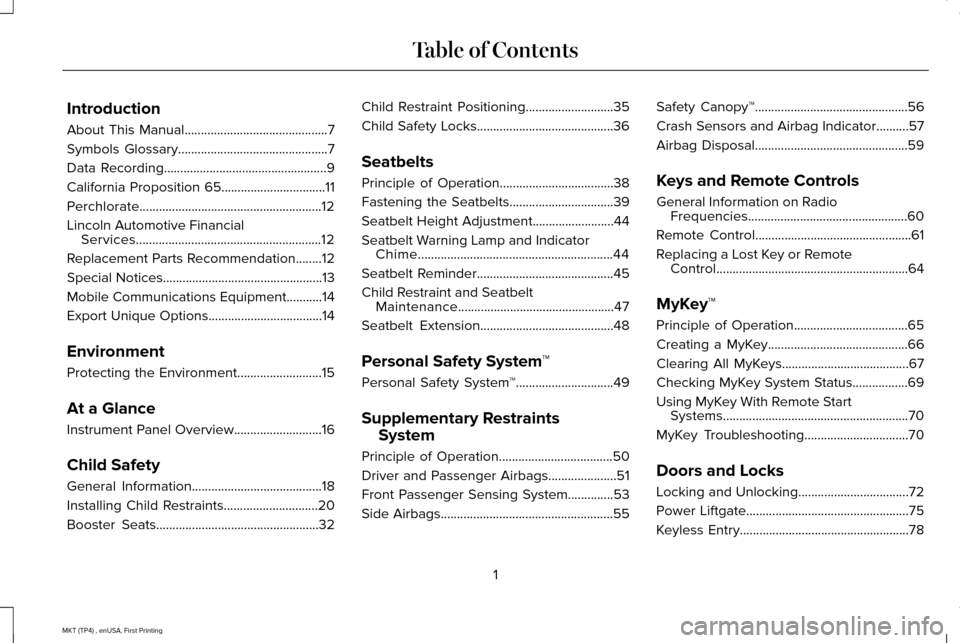
Introduction
About This Manual............................................7
Symbols Glossary
..............................................7
Data Recording
..................................................9
California Proposition 65................................11
Perchlorate........................................................12
Lincoln Automotive Financial Services
.........................................................12
Replacement Parts Recommendation........12
Special Notices
.................................................13
Mobile Communications Equipment
...........14
Export Unique Options...................................14
Environment
Protecting the Environment
..........................15
At a Glance
Instrument Panel Overview...........................16
Child Safety
General Information
........................................18
Installing Child Restraints.............................20
Booster Seats
..................................................32 Child Restraint Positioning...........................35
Child Safety Locks..........................................36
Seatbelts
Principle of Operation...................................38
Fastening the Seatbelts
................................39
Seatbelt Height Adjustment
.........................44
Seatbelt Warning Lamp and Indicator Chime
............................................................44
Seatbelt Reminder..........................................45
Child Restraint and Seatbelt Maintenance................................................47
Seatbelt Extension
.........................................48
Personal Safety System ™
Personal Safety System ™
..............................49
Supplementary Restraints System
Principle of Operation...................................50
Driver and Passenger Airbags.....................51
Front Passenger Sensing System..............53
Side Airbags.....................................................55 Safety Canopy™
...............................................56
Crash Sensors and Airbag Indicator
..........57
Airbag Disposal
...............................................59
Keys and Remote Controls
General Information on Radio Frequencies.................................................60
Remote Control
................................................61
Replacing a Lost Key or Remote Control...........................................................64
MyKey™
Principle of Operation...................................65
Creating a MyKey...........................................66
Clearing All MyKeys
.......................................67
Checking MyKey System Status.................69
Using MyKey With Remote Start Systems.........................................................70
MyKey Troubleshooting
................................70
Doors and Locks
Locking and Unlocking..................................72
Power Liftgate
..................................................75
Keyless Entry....................................................78
1
MKT (TP4) , enUSA, First Printing Table of Contents
Page 21 of 558
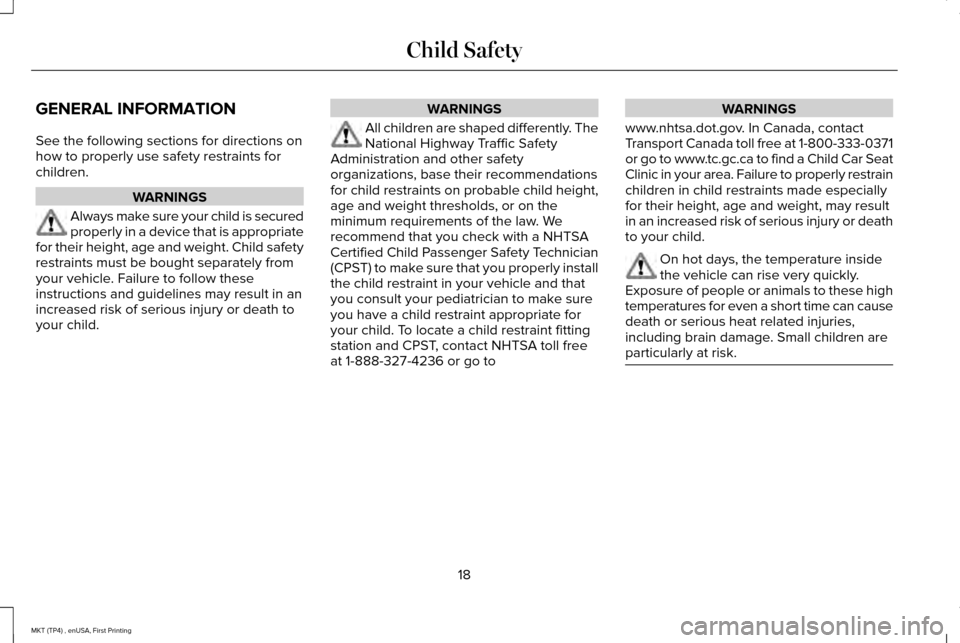
GENERAL INFORMATION
See the following sections for directions on
how to properly use safety restraints for
children.
WARNINGS
Always make sure your child is secured
properly in a device that is appropriate
for their height, age and weight. Child safety
restraints must be bought separately from
your vehicle. Failure to follow these
instructions and guidelines may result in an
increased risk of serious injury or death to
your child. WARNINGS
All children are shaped differently. The
National Highway Traffic Safety
Administration and other safety
organizations, base their recommendations
for child restraints on probable child height,
age and weight thresholds, or on the
minimum requirements of the law. We
recommend that you check with a NHTSA
Certified Child Passenger Safety Technician
(CPST) to make sure that you properly install
the child restraint in your vehicle and that
you consult your pediatrician to make sure
you have a child restraint appropriate for
your child. To locate a child restraint fitting
station and CPST, contact NHTSA toll free
at 1-888-327-4236 or go to WARNINGS
www.nhtsa.dot.gov. In Canada, contact
Transport Canada toll free at 1-800-333-0371
or go to www.tc.gc.ca to find a Child Car Seat
Clinic in your area. Failure to properly restrain
children in child restraints made especially
for their height, age and weight, may result
in an increased risk of serious injury or death
to your child. On hot days, the temperature inside
the vehicle can rise very quickly.
Exposure of people or animals to these high
temperatures for even a short time can cause
death or serious heat related injuries,
including brain damage. Small children are
particularly at risk. 18
MKT (TP4) , enUSA, First Printing Child Safety
Page 22 of 558
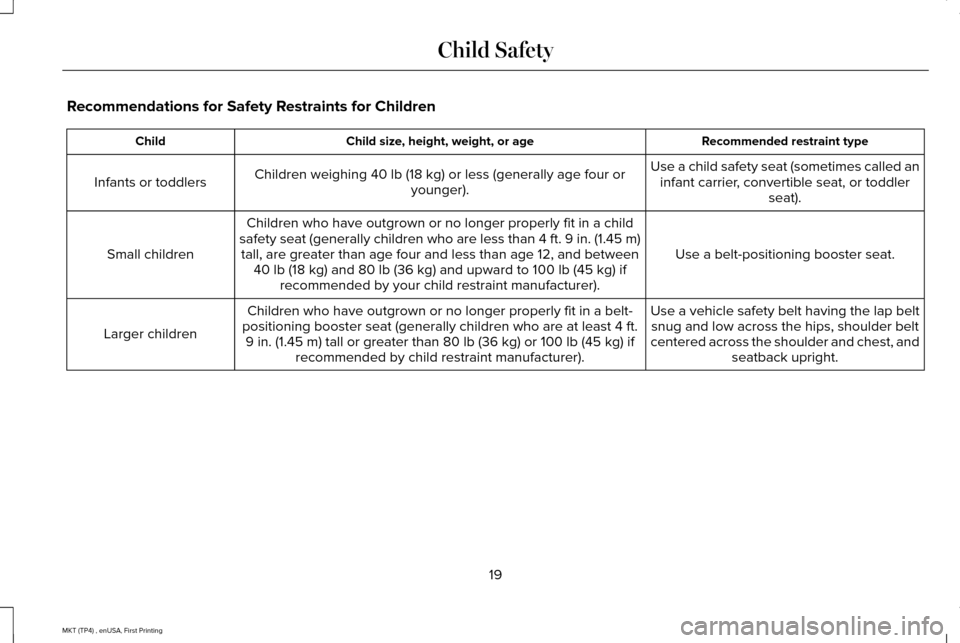
Recommendations for Safety Restraints for Children
Recommended restraint type
Child size, height, weight, or age
Child
Use a child safety seat (sometimes called aninfant carrier, convertible seat, or toddler seat).
Children weighing 40 lb (18 kg) or less (generally age four or
younger).
Infants or toddlers
Use a belt-positioning booster seat.
Children who have outgrown or no longer properly fit in a child
safety seat (generally children who are less than 4 ft. 9 in. (1.45 m)\
tall, are greater than age four and less than age 12, and between 40 lb (18 kg)
and 80 lb (36 kg) and upward to 100 lb (45 kg) if
recommended by your child restraint manufacturer).
Small children
Use a vehicle safety belt having the lap beltsnug and low across the hips, shoulder belt
centered across the shoulder and chest, and seatback upright.
Children who have outgrown or no longer properly fit in a belt-
positioning booster seat (generally children who are at least 4 ft. 9 in. (1.45 m) tall or greater than
80 lb (36 kg) or 100 lb (45 kg) if
recommended by child restraint manufacturer).
Larger children
19
MKT (TP4) , enUSA, First Printing Child Safety
Page 23 of 558

•
You are required by law to properly use
safety seats for infants and toddlers in
the United States and Canada.
• Many states and provinces require that
small children use approved booster
seats until they reach age eight, a height
of 4 feet 9 inches (1.45 meters) tall, or
80 lb (36 kg). Check your local and state
or provincial laws for specific
requirements about the safety of children
in your vehicle.
• When possible, always properly restrain
children 12 years of age and under in a
rear seating position of your vehicle.
Accident statistics suggest that children
are safer when properly restrained in the
rear seating positions than in a front
seating position.
See Front Passenger
Sensing System (page 53). INSTALLING CHILD RESTRAINTS
Child Seats
Use a child safety seat (sometimes called an
infant carrier, convertible seat, or toddler
seat) for infants, toddlers or children
weighing 40 lb (18 kg) or less (generally age
four or younger). Using Lap and Shoulder Belts WARNINGS
Airbags can kill or injure a child in a
child seat. Never place a rear-facing
child seat in front of an active airbag. If you
must use a forward-facing child seat in the
front seat, move the seat upon which the
child seat is installed all the way back. Airbags can kill or injure a child in a
child seat. Children 12 and under
should be properly restrained in the rear seat
whenever possible. Depending on where you secure a
child restraint, and depending on the
child restraint design, you may block access
to certain seatbelt buckle assemblies and
LATCH lower anchors, rendering those
features potentially unusable. To avoid risk
of injury, occupants should only use seating
positions where they are able to be properly
restrained. 20
MKT (TP4) , enUSA, First Printing Child SafetyE142594
Page 24 of 558

When installing a child safety seat with
combination lap and shoulder belts:
•
Use the correct seatbelt buckle for that
seating position.
• Insert the belt tongue into the proper
buckle until you hear a snap and feel it
latch. Make sure the tongue is securely
fastened in the buckle.
• Keep the buckle release button pointing
up and away from the safety seat, with
the tongue between the child seat and
the release button, to prevent accidental
unbuckling.
• Place the vehicle seat upon which the
child seat will be installed in the upright
position.
• For second-row seating positions, adjust
the recliner slightly to improve child seat
fit. If needed, remove the head restraints.
• For third-row seating positions, stow the
head restraints to improve child seat fit.
See Head Restraints (page 136).
• Put the seatbelt in the automatic locking
mode. See Step 5. This vehicle does not
require the use of a locking clip. Perform the following steps when installing
the child seat with combination lap and
shoulder belts:
Note:
Although the child seat illustrated is a
forward facing child seat, the steps are the
same for installing a rear facing child seat.
Note: The lock-off device on some child
restraints may not accommodate the
shoulder portion of the inflatable seatbelt.
Follow all instructions provided by the
manufacturer of the child restraint regarding
the necessary and proper use of the lock-off
device. In some instances these devices
have been provided only for use in vehicles
with seatbelt systems that would otherwise
require a locking clip. Standard seatbelts 1. Position the child safety seat in a seat
with a combination lap and shoulder belt. 21
MKT (TP4) , enUSA, First Printing Child SafetyE142528 E142529
Page 26 of 558

7.
Try to pull the belt out of the retractor to
make sure the retractor is in the
automatic locking mode (you should not
be able to pull more belt out). If the
retractor is not locked, unbuckle the belt
and repeat Steps 5 and 6. 8. Remove remaining slack from the belt.
Force the seat down with extra weight,
for example, by pressing down or
kneeling on the child restraint while
pulling up on the shoulder belt in order
to force slack from the belt. This is
necessary to remove the remaining slack
that will exist once the extra weight of the child is added to the child restraint.
It also helps to achieve the proper
snugness of the child seat to your
vehicle. Sometimes, a slight lean toward
the buckle will provide extra help to
remove remaining slack from the belt.
9. Attach the tether strap (if the child seat is equipped). 10. Before placing the child in the seat,
forcibly move the seat forward and back
to make sure the seat is securely held
in place. To check this, grab the seat at
the belt path and attempt to move it
side to side and forward and back.
There should be no more than 1 inch
(2.5 centimeters) of movement for
proper installation.
We recommend checking with a NHTSA
Certified Child Passenger Safety Technician
to make certain the child restraint is properly
installed. In Canada, check with Transport
Canada for referral to a Child Car Seat Clinic.
23
MKT (TP4) , enUSA, First Printing Child SafetyE142533 E142534
Page 28 of 558
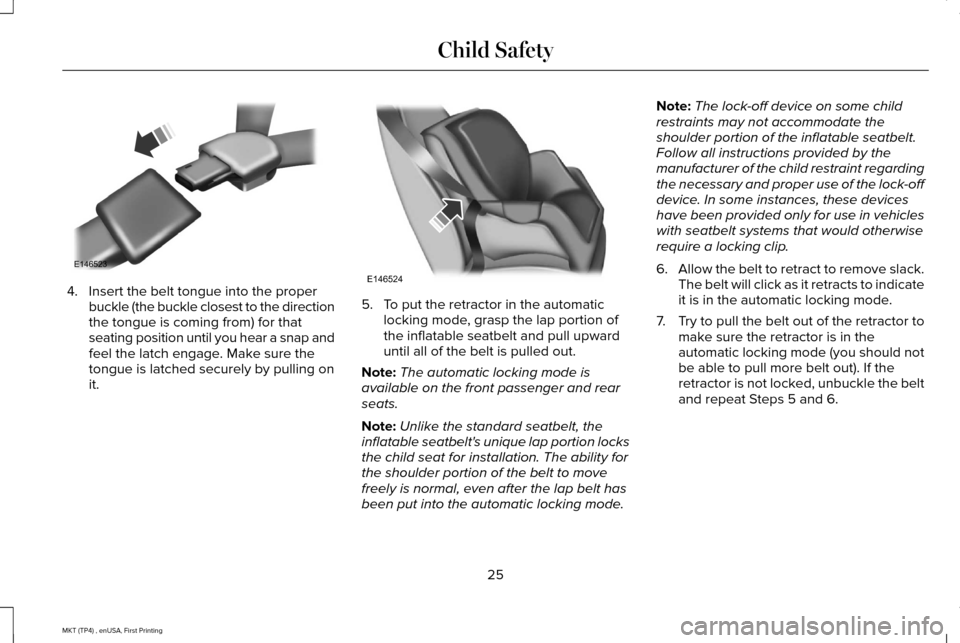
4. Insert the belt tongue into the proper
buckle (the buckle closest to the direction
the tongue is coming from) for that
seating position until you hear a snap and
feel the latch engage. Make sure the
tongue is latched securely by pulling on
it. 5. To put the retractor in the automatic
locking mode, grasp the lap portion of
the inflatable seatbelt and pull upward
until all of the belt is pulled out.
Note: The automatic locking mode is
available on the front passenger and rear
seats.
Note: Unlike the standard seatbelt, the
inflatable seatbelt's unique lap portion locks
the child seat for installation. The ability for
the shoulder portion of the belt to move
freely is normal, even after the lap belt has
been put into the automatic locking mode. Note:
The lock-off device on some child
restraints may not accommodate the
shoulder portion of the inflatable seatbelt.
Follow all instructions provided by the
manufacturer of the child restraint regarding
the necessary and proper use of the lock-off
device. In some instances, these devices
have been provided only for use in vehicles
with seatbelt systems that would otherwise
require a locking clip.
6. Allow the belt to retract to remove slack.
The belt will click as it retracts to indicate
it is in the automatic locking mode.
7. Try to pull the belt out of the retractor to
make sure the retractor is in the
automatic locking mode (you should not
be able to pull more belt out). If the
retractor is not locked, unbuckle the belt
and repeat Steps 5 and 6.
25
MKT (TP4) , enUSA, First Printing Child SafetyE146523 E146524
Page 29 of 558
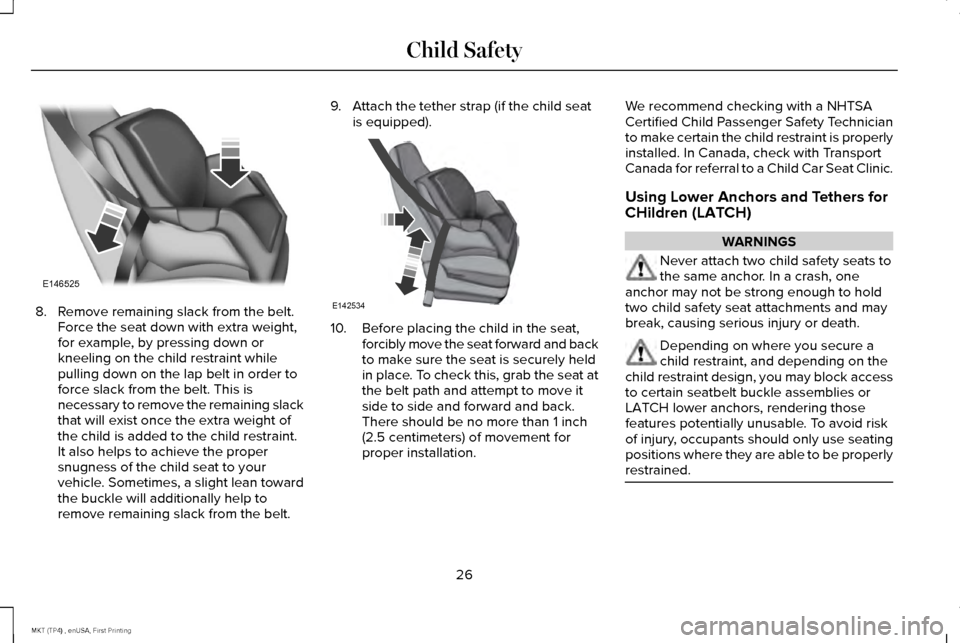
8. Remove remaining slack from the belt.
Force the seat down with extra weight,
for example, by pressing down or
kneeling on the child restraint while
pulling down on the lap belt in order to
force slack from the belt. This is
necessary to remove the remaining slack
that will exist once the extra weight of
the child is added to the child restraint.
It also helps to achieve the proper
snugness of the child seat to your
vehicle. Sometimes, a slight lean toward
the buckle will additionally help to
remove remaining slack from the belt. 9. Attach the tether strap (if the child seat
is equipped). 10. Before placing the child in the seat,
forcibly move the seat forward and back
to make sure the seat is securely held
in place. To check this, grab the seat at
the belt path and attempt to move it
side to side and forward and back.
There should be no more than 1 inch
(2.5 centimeters) of movement for
proper installation. We recommend checking with a NHTSA
Certified Child Passenger Safety Technician
to make certain the child restraint is properly
installed. In Canada, check with Transport
Canada for referral to a Child Car Seat Clinic.
Using Lower Anchors and Tethers for
CHildren (LATCH) WARNINGS
Never attach two child safety seats to
the same anchor. In a crash, one
anchor may not be strong enough to hold
two child safety seat attachments and may
break, causing serious injury or death. Depending on where you secure a
child restraint, and depending on the
child restraint design, you may block access
to certain seatbelt buckle assemblies or
LATCH lower anchors, rendering those
features potentially unusable. To avoid risk
of injury, occupants should only use seating
positions where they are able to be properly
restrained. 26
MKT (TP4) , enUSA, First Printing Child SafetyE146525 E142534
Page 33 of 558
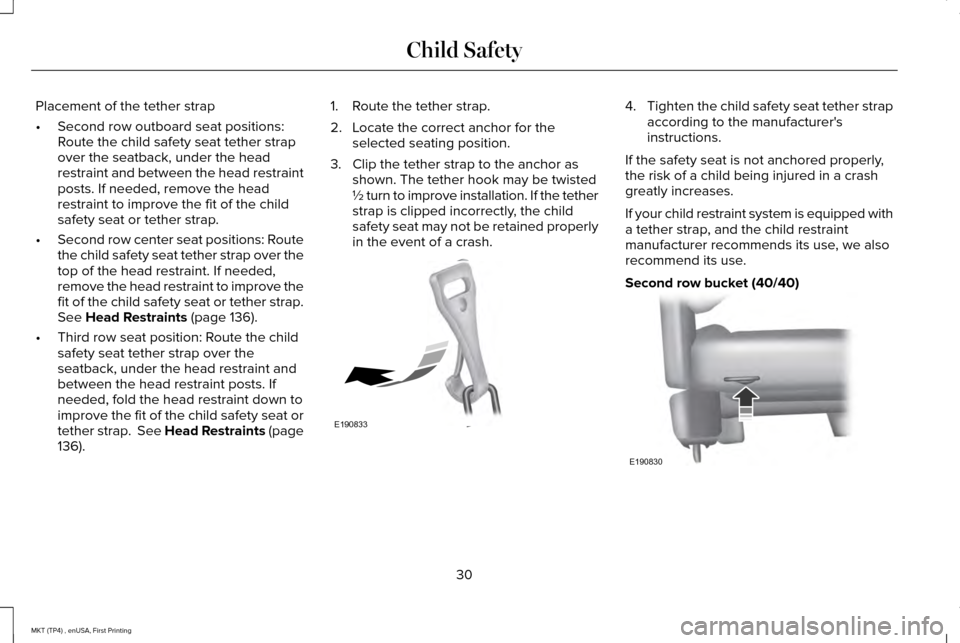
Placement of the tether strap
•
Second row outboard seat positions:
Route the child safety seat tether strap
over the seatback, under the head
restraint and between the head restraint
posts. If needed, remove the head
restraint to improve the fit of the child
safety seat or tether strap.
• Second row center seat positions: Route
the child safety seat tether strap over the
top of the head restraint. If needed,
remove the head restraint to improve the
fit of the child safety seat or tether strap.
See Head Restraints (page 136).
• Third row seat position: Route the child
safety seat tether strap over the
seatback, under the head restraint and
between the head restraint posts. If
needed, fold the head restraint down to
improve the fit of the child safety seat or
tether strap. See Head Restraints (page
136
). 1. Route the tether strap.
2. Locate the correct anchor for the
selected seating position.
3. Clip the tether strap to the anchor as shown. The tether hook may be twisted
½ turn to improve installation. If the tether
strap is clipped incorrectly, the child
safety seat may not be retained properly
in the event of a crash. 4.
Tighten the child safety seat tether strap
according to the manufacturer's
instructions.
If the safety seat is not anchored properly,
the risk of a child being injured in a crash
greatly increases.
If your child restraint system is equipped with
a tether strap, and the child restraint
manufacturer recommends its use, we also
recommend its use.
Second row bucket (40/40) 30
MKT (TP4) , enUSA, First Printing Child SafetyE190833 E190830
Page 35 of 558
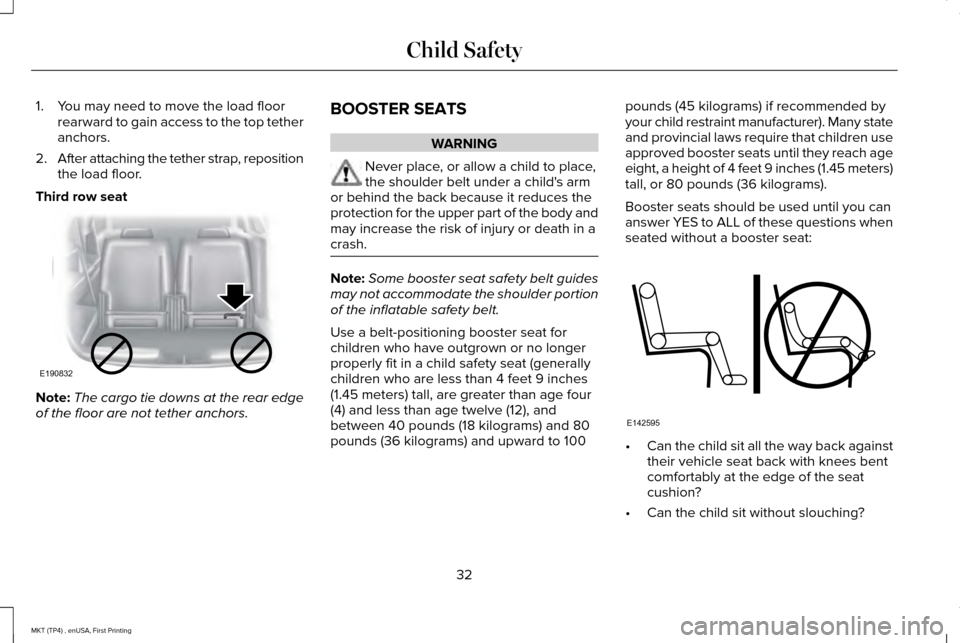
1. You may need to move the load floor
rearward to gain access to the top tether
anchors.
2. After attaching the tether strap, reposition
the load floor.
Third row seat Note:
The cargo tie downs at the rear edge
of the floor are not tether anchors. BOOSTER SEATS WARNING
Never place, or allow a child to place,
the shoulder belt under a child's arm
or behind the back because it reduces the
protection for the upper part of the body and
may increase the risk of injury or death in a
crash. Note:
Some booster seat safety belt guides
may not accommodate the shoulder portion
of the inflatable safety belt.
Use a belt-positioning booster seat for
children who have outgrown or no longer
properly fit in a child safety seat (generally
children who are less than 4 feet 9 inches
(1.45 meters) tall, are greater than age four
(4) and less than age twelve (12), and
between 40 pounds (18 kilograms) and 80
pounds (36 kilograms) and upward to 100 pounds (45 kilograms) if recommended by
your child restraint manufacturer). Many state
and provincial laws require that children use
approved booster seats until they reach age
eight, a height of 4 feet 9 inches (1.45 meters)
tall, or 80 pounds (36 kilograms).
Booster seats should be used until you can
answer YES to ALL of these questions when
seated without a booster seat:
•
Can the child sit all the way back against
their vehicle seat back with knees bent
comfortably at the edge of the seat
cushion?
• Can the child sit without slouching?
32
MKT (TP4) , enUSA, First Printing Child SafetyE190832 E142595